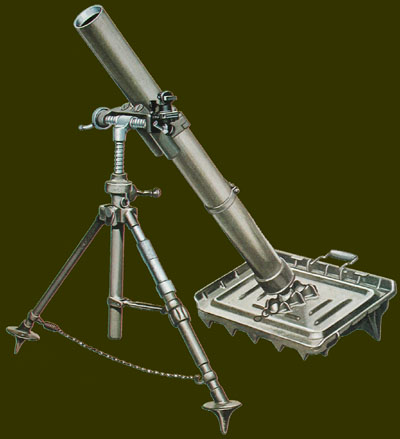|
Mortars - Bombardment from Short Range
During World War I the British developed a new class of weapon, the infantry mortar.
Sir Frederick Wilfrid Scott Stokes invented an innovative design which was light and portable. It could be rapidly deployed by a crew of three.
This solved the limited mobility problem inherent with existing "trench mortar" types, which are better classified as pocket artillery.
The Stokes mortar was muzzle loaded and fired a 3 or 4 inch diameter un-stabilized cylindrical projectile from a smooth-bore barrel attached to a base-plate.
The barrel was supported by a bipod assembly with a screw adjustment for elevating and transversing the muzzle.
The tube, base plate and bipod could be quickly dismantled and transported.
The projectile (or "bomb") was completely self-contained. The propellant was held in small bags at the base, which was fitted with an initiating cartridge.
Gravity operated, the round was dropped into the tube and when it reached the bottom it hit a fixed firing pin, which fired a primer in the initiating
cartridge, igniting the propellant. The entire shell was launched out the muzzle.
The now empty tube was ready for the next round. The fuze was an impact "always" design with a bore safety, which armed after it left the
muzzle. The Stokes Mortar was simple and effective.
After the war a French designer, Edgar William Brandt, further improved the mortar by incorporating
a finned projectile, with an improved gas check system, as well as a collimator-type sight. This gave better
range and accuracy. The "Stokes-Brandt" mortar design was highly successful
and adopted by many nations during WWII.
Today the Infantry Mortar continues to fill the gap between grenades and artillery, providing artillery-like fire support for rapidly moving front
line troops. It can reach out and bombard enemy positions using indirect fire from protected positions. Comparing the weight of the weapon to that of the
ordnance delivered on target, the mortar is a most efficient weapon.
|

